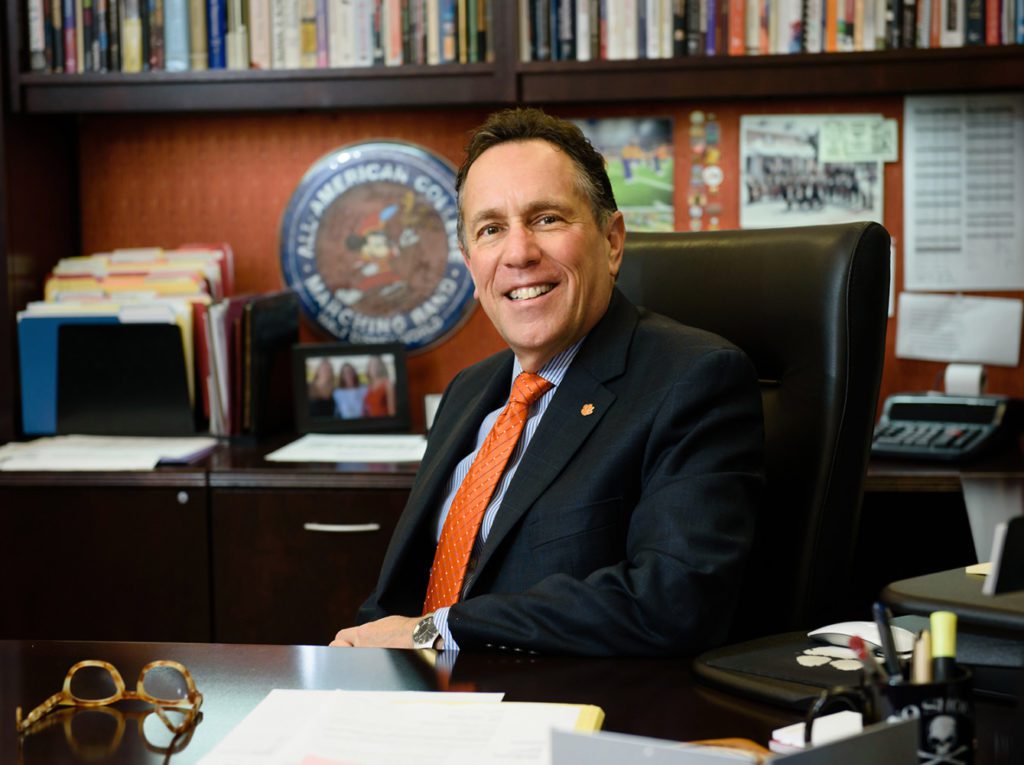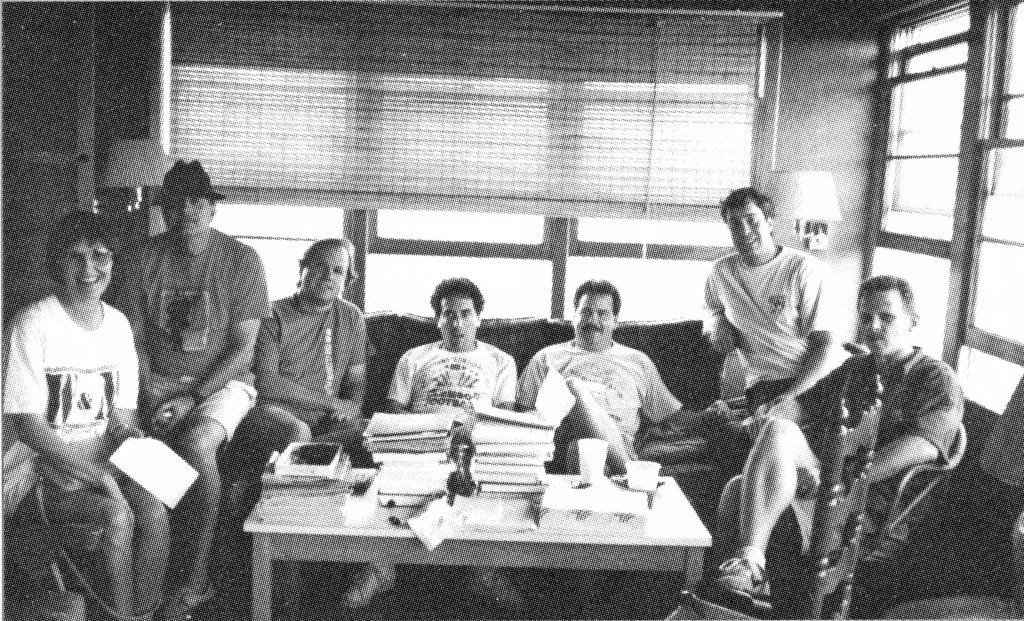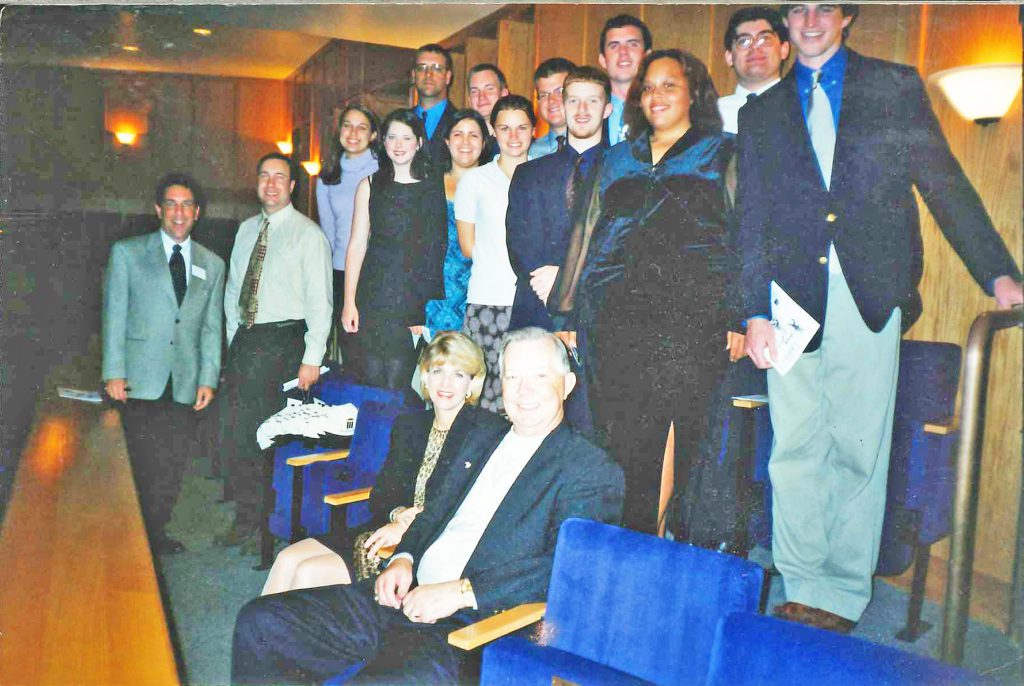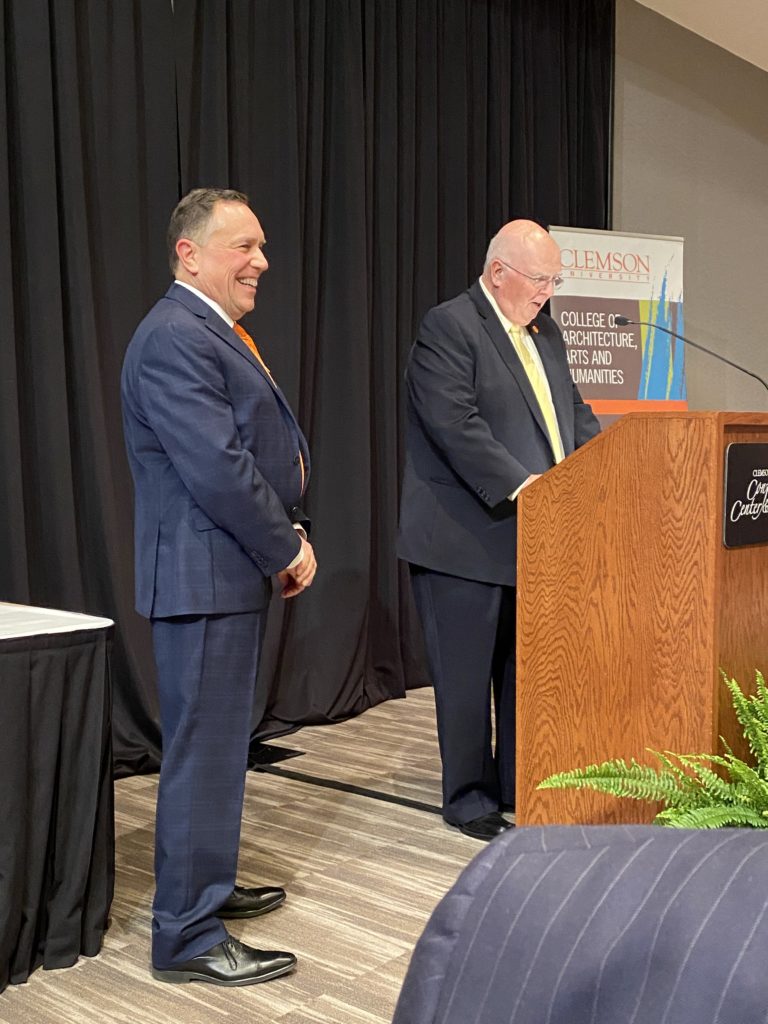From Band Director to Department Chair to Dean, Rick Goodstein will be remembered for his visionary leadership and his work to establish Clemson’s nationally distinctive performing arts program.

“As Joe Sherman wrote in 1934, ‘there’s something in these hills…’”
When Rick Goodstein arrived as a young band director in 1982, he could not have dreamed that Clemson would be home to his distinguished career for the next four decades. “As is the case with many of my generation, we always thought Clemson would be a short stop on our way to something else,” he explains. At the time, 29-year-old Goodstein was finishing up his graduate work in music education at Arizona State University and hunting for a marching band job–preferably one with a ‘big time’ football program. Coincidentally, the Clemson Tigers were just off the heels of the thrilling 1981 National Championship. “Other than knowing about coach Danny Ford and the fans wearing funny looking orange overalls, I didn’t know much of anything about Clemson University,” he recounts.
Thankfully, destiny took over, and Goodstein soon received an offer from Clemson to be the new Assistant Director of Bands. “It didn’t take long to say yes (like a minute!),” remembers Goodstein. During his tenure, Tiger Band made the innovative switch from pen and paper to computers, drastically reducing the time it took to generate drill formations. Goodstein climbed the ranks, and by 1990 he was promoted to Director of Bands, overseeing all 300 musicians of the booming “Band that shakes the Southland.”
Over the next decade, Goodstein would also help build Clemson’s performing arts program from the ground up—beginning quite literally in 1991 with the groundbreaking of the Brooks Center, the long awaited 87,000 square-foot campus performing arts facility. He and other faculty provided valuable insight to the architects, tailoring the building perfectly to Clemson’s needs and priorities. By 1994, the Brooks Center was complete, and the music and theatre faculty finally had a home on campus in a state-of-the-art facility. However, their sights were already set on their next big goal.
On July 1, 1998, Goodstein assumed the role of Chair of the Department of Performing Arts, a position he held for 12 pivotal years. Although the department had been flourishing under the leadership of theatre director and chair Chip Egan, it was the only department in the College of Architecture, Arts and Humanities to not offer a bachelor’s degree. Rather, it was considered a “service unit” to house student ensembles and provide general education classes to undergraduates. “I knew, as did others on the faculty including Chip, Mickey Harder, and David Hartmann, that if we were to thrive during the maturation of Clemson University as a Top-20 university, we had to develop a viable major,” said Goodstein. The faculty got to work developing a program, working within their limited resources as a service-based unit, and taking into account Clemson’s land-grant status and its history as an agricultural and engineering-focused university.
Members of that inaugural committee fondly remember a 1990 beach retreat at the Edisto Island home of Lillian “Mickey” Harder, now director emerita of the Brooks Center. Creativity flowed as music and theatre faculty brainstormed and strategized about the possibilities. “Rick is a creator,” says David Hartmann, Professor of Theatre and former department chair. “I remember being inspired by hearing Rick and another faculty member play the saxophone at the beach on Edisto. I believe music rolling off the waves each night at our retreat helped spark a unique performing arts program.”

“We knew that the newly occupied Brooks Center had to be the centerpiece of the major,” recounts Goodstein. The 1,000-seat theatre was designed to function as a home for student performances as well as a roadhouse for world-class traveling artists and attractions, making it a unique immersive learning environment. What emerged was a nationally distinctive program designed to prepare students for a variety of careers in the arts, while also encouraging them to pursue their passion and develop their craft. “Unlike traditional music and theatre programs—which are designed to produce performers or arts educators—the Clemson degree concentrates on corollary areas of performing, such as stage management, sound and lighting design, and box office management,” Goodstein explained. The proposed “Bachelor of Arts in Production Studies in Performing Arts” featured a common core curriculum and offered concentrations in three areas: music, theatre, and audio technology. “We finally had a degree we believed in,” said Goodstein.
It would take yet a few more years before the major would become official. David Hartmann recalls Goodstein’s perseverance during the rigorous vetting process. “Not only did Rick participate in the writing of the curriculum—he advanced the degree as it passed through all the hurdles at the university and state levels.” In 2001, much to the delight of the dedicated faculty, Clemson University President Jim Barker and Provost Dori Helms received their proposal with enthusiastic support. The Clemson Board of Trustees soon followed with their endorsement, and on July 12, 2001, the South Carolina Commission on Higher Education granted approval for Clemson’s new performing arts degree. The department was finally able to offer its major, a dream nearly 10 years in the making.
Goodstein’s vision led to immediate success, and by 2003 the department saw its very first class of graduating seniors. Affectionately nicknamed the “Dirty Dozen,” the first 12 majors paved the way for hundreds to follow. Today, nearly 20 years later, the halls of the Brooks Center are bustling with 86 majors and 101 minors. As Mickey Harder shares, “The program has produced graduates who have excelled in positions at many of the most prestigious theatres and performing arts centers in the United States.” Its alumni have become Disney marketing executives, Broadway costume designers, Hollywood screenwriters, Nashville recording artists and nationally touring audio engineers. Goodstein maintains close friendships with many alumni and never tires of hearing their accomplishments. “Seeing the first class of 12 performing arts majors and all those who followed become successful professionals is something that I take pride in every time I learn of another student’s success story,” he adds.

Goodstein remained chair of the department until summer 2010, when he was named Interim Dean of the College of Architecture, Arts and Humanities. A year later, he was appointed to the position on a permanent basis after a national search. In his first years as Dean, Goodstein led the implementation of an 18% budget cut in response to the Great Recession of 2008. “One of my proudest achievements was allocating the $3.1 million budget cut without letting go of any faculty or staff, and maintaining quality within each of our academic degree programs,” said Goodstein.
In the years that followed, Dean Goodstein expanded scholarship opportunities and other initiatives through more than $35 million in private gifts, bequests and other private giving to the college. In 2012, he oversaw the expansion of architecture facility Lee III, one of the most energy-efficient academic buildings in the United States; and in 2014, he oversaw the fundraising and design of the new Tiger Band Plaza, a project dear to his heart. Named for former band directors and Goodstein’s longtime mentors, John H. Butler and Bruce F. Cook, the plaza serves as a gateway to the outdoor rehearsal space and commemorative destination for alumni and fans. During this important project and throughout his nine years as Dean, Goodstein enjoyed revisiting his origins as band leader, taking the stand during at least one home game per season to conduct the Tiger Band.

In 2017, Dean Goodstein established the CAAH Hall of Fame to honor exceptional alumni, faculty, staff and friends of the college who have made a significant impact to its educational, research, and service goals. Fittingly, in 2019, upon stepping down from his role as Dean, Goodstein himself was inducted into the CAAH Hall of Fame by Interim Dean Tim Boosinger on March 6, 2020. “Dean Goodstein has provided strong and passionate leadership in the College of Architecture, Arts and Humanities for nine years,” said Clemson University President James P. Clements. “His devoted service to the university and his commitment to excellence will have an enduring impact on Clemson students and alumni, faculty and staff. Rick also is an accomplished teacher and I am pleased that he will continue to share his knowledge and experience with our students in the classroom.”

In August 2019, Goodstein returned to his roots in the classroom and rejoined the faculty of the Performing Arts Department, teaching music courses and shepherding the next generation of talented students. He concluded his forty-year Clemson career on December 31, 2021.
Mickey Harder shares, “When I think of Rick’s career as band director, professor, chair, and dean, three things come to mind: his passion for excellence in all aspects, his dedication to providing students with the tools needed to succeed, and his meticulous attention to details. Rick will be remembered for striving to make Clemson the best it could be in the performing arts arena.” Goodstein’s legacy will continue in the lives of performing arts students past, present and future, who are the beneficiaries of his imagination and tenacity.
In his retirement, Dr. Goodstein plans to spend quality time with his family and five grandchildren at his new getaway in Cashiers, North Carolina. “I also plan to work on my tennis and non-existent golf games,” adds Goodstein. In any case, surely Clemson will remain an irreplaceable part of his life, as it has been for the past 40 years. “As Joe Sherman, Class of 1934 said, ‘There’s something in these hills…’,” Goodstein said. “It’s been a remarkable journey.”
Written by Caroline Ritchie Stahl, Director of Public Relations at the Brooks Center for the Performing Arts. Special thanks to Mickey Harder and David Hartmann for their contribution of photos and thoughtful reflections.
Get in touch and we will connect you with the author or another expert.
Or email us at news@clemson.edu

